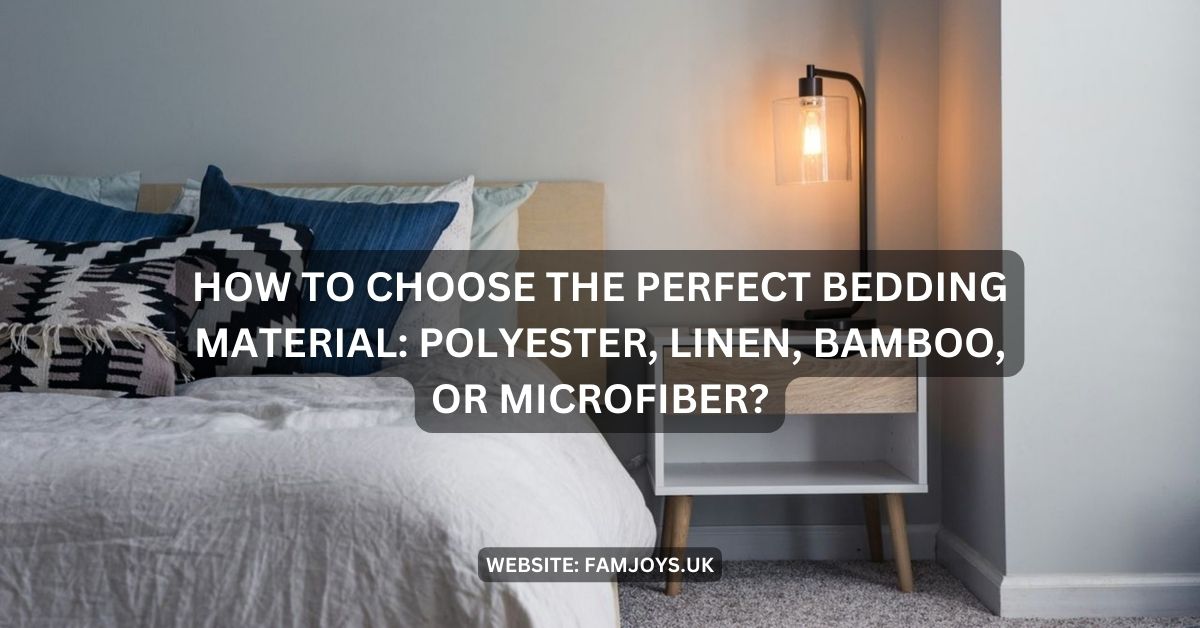Blog
How to Choose the Perfect Bedding Material: Polyester, Linen, Bamboo, or Microfiber?
When it comes to creating the perfect sleep environment, your choice of bedding material plays a crucial role. The fabric you choose can affect everything from how comfortable you feel at night to how well your bedding holds up over time. With so many options available—polyester, linen, bamboo, and microfiber—it can be overwhelming to decide which one is right for you. In this guide, we’ll break down the pros and cons of each material to help you make an informed decision based on your sleep style and climate.
1. Polyester: The Versatile Synthetic
Pros:
- Affordable: Polyester is one of the most budget-friendly bedding materials, making it accessible for a wide range of shoppers.
- Durable: Polyester is highly durable and resistant to wear and tear, meaning it can last a long time without losing its shape or color.
- Wrinkle-Resistant: Unlike natural fibers like cotton or linen, polyester resists wrinkles, giving your bedding a smooth, polished look with minimal effort.
- Stain-Resistant: Polyester is naturally resistant to stains, making it a practical choice for households with kids, pets, or frequent spills.
- Quick-Drying: Polyester dries quickly after washing, which is convenient for those who need their bedding ready to use in a hurry.
Cons:
- Not Breathable: Polyester doesn’t breathe as well as natural fibers, which can lead to overheating in warmer climates or for hot sleepers.
- Less Softness: While polyester can feel soft, it often doesn’t match the luxurious feel of natural fibers like cotton or bamboo.
- Environmental Concerns: Polyester is made from synthetic materials derived from petroleum, which are not biodegradable and can contribute to microplastic pollution.
Best For: Budget-conscious shoppers who prioritize durability and low maintenance. Ideal for cooler climates or those who don’t sleep hot.
2. Linen: The Natural Luxury
Pros:
- Temperature Regulation: Linen is excellent at regulating temperature, keeping you cool in summer and warm in winter.
- Eco-Friendly: Made from flax plants, linen is one of the most sustainable and eco-friendly bedding materials available.
- Durability: Linen gets softer and more durable with each wash, making it a long-term investment.
- Aesthetic Appeal: Linen has a natural, textured look that adds a touch of elegance to any bedroom.
Cons:
- Rougher Texture Initially: Linen can feel rougher than other fabrics when new, but it softens over time.
- Wrinkles Easily: Like polyester, linen wrinkles easily, giving it a more relaxed, lived-in appearance.
- Higher Cost: Linen is often more expensive than polyester or microfiber due to its labor-intensive production process.
Best For: Eco-conscious shoppers who value sustainability and temperature regulation. Great for both warm and cool climates.
3. Bamboo: The Eco-Friendly Innovator
Pros:
- Ultra-Soft: Bamboo fabric is incredibly soft, often compared to silk or cashmere, making it a favorite for those who love luxury.
- Moisture-Wicking: Bamboo is naturally moisture-wicking, helping to keep you dry and comfortable throughout the night.
- Antibacterial Properties: Bamboo has natural antibacterial properties, making it an excellent choice for allergy sufferers.
- Sustainable: Bamboo grows quickly and requires minimal water and pesticides, making it an environmentally friendly option.
Cons:
- Less Durable: Bamboo fabric can pill or lose its softness over time, especially with frequent washing.
- Chemical Processing Concerns: Some bamboo fabrics are processed using chemicals, which can raise environmental concerns depending on the manufacturing process.
- Higher Price Point: Bamboo bedding tends to be more expensive than polyester or microfiber.
Best For: Those looking for a soft, eco-friendly option with moisture-wicking properties. Ideal for hot sleepers or humid climates.
4. Microfiber: The Budget-Friendly Option
Pros:
- Affordable: Microfiber is one of the most budget-friendly bedding materials, making it accessible for a wide range of shoppers.
- Soft and Smooth: Microfiber has a smooth, silky texture that feels luxurious without breaking the bank.
- Stain-Resistant: Microfiber is highly resistant to stains, making it a practical choice for households with kids or pets.
- Low Maintenance: Microfiber is easy to care for and dries quickly, making it a convenient option for busy lifestyles.
Cons:
- Not Breathable: Microfiber doesn’t breathe as well as natural fibers, which can lead to overheating in warmer climates.
- Less Durable: Over time, microfiber can pill or lose its softness, especially with frequent washing.
- Environmental Concerns: Microfiber is made from synthetic materials like polyester, which are not biodegradable and can contribute to microplastic pollution.
Best For: Budget-conscious shoppers who want a soft, low-maintenance option. Best suited for cooler climates or those who don’t sleep hot.
How to Choose the Right Material for Your Sleep Style and Climate
Now that you know the pros and cons of each material, here’s how to narrow down your choice based on your personal needs:
- Sleep Style:
- Hot Sleepers: If you tend to sleep hot, opt for breathable materials like bamboo or linen. These fabrics will help regulate your body temperature and keep you cool throughout the night.
- Cold Sleepers: For those who get chilly at night, polyester or microfiber might be the best option. Polyester, in particular, retains warmth while still being lightweight.
- Climate:
- Warm Climates: Bamboo and linen are excellent choices for hot or humid environments because they wick moisture and allow air to circulate.
- Cool Climates: Polyester or microfiber can provide extra warmth without trapping too much heat, making them ideal for colder regions.
- Lifestyle:
- Eco-Conscious Shoppers: If sustainability is important to you, consider bamboo or linen, both of which are eco-friendly options.
- Budget-Conscious Buyers: Polyester and microfiber are the most affordable options, while still offering durability and stain resistance.
Conclusion
Choosing the perfect bedding material ultimately comes down to your personal preferences, sleep habits, and environmental considerations. Whether you’re looking for the versatility of polyester, the natural luxury of linen, the eco-friendly softness of bamboo, or the budget-friendly convenience of microfiber, there’s a material out there that’s perfect for you.
Remember, the best bedding is the one that helps you get the restful, rejuvenating sleep you deserve. So take your time, weigh the pros and cons, and invest in the material that aligns with your lifestyle and climate. Sweet dreams!
Stay tuned for our next blog post, where we’ll dive into “The Ultimate Guide to Bedding Sizes: How to Choose the Right Fit for Your Mattress.”

